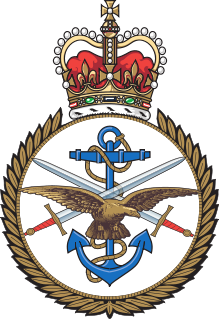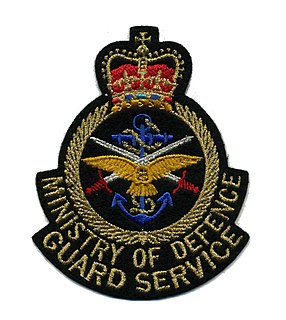Related Research Articles

The Royal Air Force (RAF) is the United Kingdom's air and space force. It was formed towards the end of the First World War on 1 April 1918, becoming the first independent air force in the world, by regrouping the Royal Flying Corps (RFC) and the Royal Naval Air Service (RNAS). Following the Allied victory over the Central Powers in 1918, the RAF emerged as the largest air force in the world at the time. Since its formation, the RAF has taken a significant role in British military history. In particular, it played a large part in the Second World War where it fought its most famous campaign, the Battle of Britain.

The British Armed Forces, also known as Her Majesty's Armed Forces, are the military services responsible for the defence of the United Kingdom, its Overseas Territories and the Crown Dependencies. They also promote the UK's wider interests, support international peacekeeping efforts and provide humanitarian aid.

The Ministry of Defence is the British government department responsible for implementing the defence policy set by Her Majesty's Government, and is the headquarters of the British Armed Forces.

Skynet is a family of military communications satellites, now operated by Airbus Defence and Space on behalf of the United Kingdom's Ministry of Defence (MoD). They provide strategic and tactical communication services to the branches of the British Armed Forces, the British intelligence agencies, some UK government departments and agencies, and to allied governments. Since 2015 when Skynet coverage was extended eastward, and in conjunction with an Anik G1 satellite module over America, Skynet offers near global coverage.

Defence Intelligence (DI) is an organisation within the United Kingdom intelligence community which focuses on gathering and analysing military intelligence. It differs from the UK's intelligence agencies in that it is an integral part of a government department – the Ministry of Defence (MoD) – rather than a stand-alone organisation. The organisation employs a mixture of civilian and military staff and is funded within the UK's defence budget. The organisation was formerly known as the Defence Intelligence Staff (DIS), but changed its name in 2009.

The Queen Elizabeth class is a class of two aircraft carriers of the United Kingdom's Royal Navy which are the central components of the UK Carrier Strike Group. The lead ship, HMS Queen Elizabeth, was named on 4 July 2014, in honour of Elizabeth I. She was commissioned on 7 December 2017. The second, HMS Prince of Wales, was launched on 21 December 2017, and was commissioned on 10 December 2019.

Future planning of the Royal Navy's capabilities is set through periodic Defence Reviews carried out by the British Government. The Royal Navy's role in the 2020s, and beyond, is outlined in the 2021 defence white paper, which was published on 22 March 2021. The white paper is one component of the Integrated Review of Security, Defence, Development and Foreign Policy, titled as Global Britain in a Competitive Age which was published on 16 March 2021.
Qinetiq is a British multinational defence technology company headquartered in Farnborough, Hampshire, England. It is the world's 52nd-largest defence contractor measured by 2011 defence revenues, and the sixth-largest based in the United Kingdom.

The Ministry of Defence Guard Service (MGS) is part of the Defence Infrastructure Organisation of the Ministry of Defence, it provides military establishments across the United Kingdom with guarding and patrol services and was established as a response to the Deal Bombing. The Guard Service is one of the few remaining uniformed Civil Service agencies within the UK, and has been named an elite guarding service within the United Kingdom.
Bowman is the name of the tactical communications system used by the British Armed Forces.

Defence Infrastructure Organisation (DIO) is an operating arm of the Ministry of Defence (MoD) in the United Kingdom, which is responsible for the built and rural estate. Its Chief Executive is Graham Dalton.
Corporate Headquarters Office Technology System (CHOTS) was a restricted electronic mail and office administration system used by the Ministry of Defence of the United Kingdom.
The Oil and Pipelines Agency (OPA) is a statutory corporation of the Ministry of Defence (MoD) in the United Kingdom. Its current role is to operate six coastal Oil Fuel Depots on behalf of the MoD. The OPA was also previously responsible for the management of the Government Pipelines and Storage System (GPSS), until its sale in 2015. The OPA is the MoD's professional expert on bulk fuel storage and transportation by pipeline.
Joint Personnel Administration (JPA) is the intranet-based personnel administration system used by the British Armed Forces from April 2006 onwards, replacing the separate payment and administration teams from each of the three Services. Despite the ability to carry out over 40 formerly paper-based functions, from checking postings to payslips, the system has been heavily criticised.
The Atlas Consortium comprises four partner companies; DXC Technology, Fujitsu, Airbus Defence and Space and CGI. Each Atlas partner has extensive experience of major technology implementation programmes in both the public and private sectors. Some 3,000 IT professionals have worked on the development and delivery of the ATLAS programme.

The Ministry of Defence Police (MDP) is a civilian special police force which is part of the United Kingdom's Ministry of Defence. The MDP's primary responsibilities are to provide armed security and counter terrorism services to designated high-risk areas, as well as uniformed policing and limited investigative services to Ministry of Defence property, personnel, and installations throughout the United Kingdom. The MDP are not military police and should not be confused with the Royal Military Police or any other British Service Police. Service personnel often refer to the MDP by the nickname "MOD plod".

HMS Agincourt is an Astute-class nuclear-powered fleet submarine under construction for the Royal Navy and the seventh in her class. The boat's name was confirmed in May 2018, having previously held the in-work name of Ajax.

The UK Military Flying Training System (UKMFTS) takes UK armed forces aircrew from initial training through elementary, basic, and advanced flying training phases, preparing them for their arrival at their designated operational aircraft units. It is operated by Ascent Flight Training, a consortium of Lockheed Martin and Babcock International under a 25-year Private Finance Initiative (PFI) contract for the UK's Ministry of Defence (MoD), with oversight from the MoD. The airworthiness authority for each aircraft type, for example, is fulfilled by military and civilian staff within Defence Equipment and Support. Apart from the overall contract, the main elements of the system include fixed-wing elementary, multi-engine and fast-jet pilot training, rear crew training and rotary-wing (helicopter) training.

Operation Rescript is the code name for the British military operation to help tackle the ongoing COVID-19 pandemic in the United Kingdom and its Crown Dependencies. It has been described as the UK's "biggest ever homeland military operation in peacetime" by the Ministry of Defence (MOD), involving up to 23,000 personnel within a specialist task force, named the COVID Support Force (CSF). The support is given at the request of the UK government, its devolved administrations and civil authorities through the Military aid to the civil authorities (MACA) mechanism.
References
- 1 2 Collins, Tony (16 January 2009). "MoD concealed the truth on £7bn DII project costs". Computer Weekly .
- ↑ Rush, By Julian (15 November 2007). "MoD system: 'unmitigated disaster'". Channel 4 News . Archived from the original on 2016-03-04.
- ↑ Ministry of Defence: The Defence Information Infrastructure. National Audit Office. July 4, 2008. ISBN 9780102954227. HC: 788 2007-2008.
- ↑ Baroness Taylor of Bolton, Minister of State for International Defence and Security (19 January 2010). "Armed Forces: Defence Information Infrastructure". Parliamentary Debates (Hansard) . United Kingdom: House of Lords. col. WS37–38. Archived from the original on 2010-04-23.